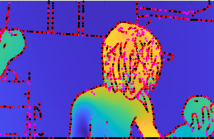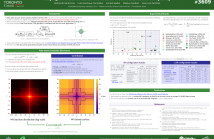

- Read more about An Efficient Compression Method For Sign Information Of DCT Coefficients Via Sign Retrieval
- Log in to post comments
Compression of the sign information of discrete cosine transform coefficients is an intractable problem in image compression schemes due to the equiprobable occurrence of the sign bits. To overcome this difficulty, we propose an efficient compression method for such sign information based on phase retrieval, which is a classical signal restoration problem attempting to find the phase information of discrete Fourier transform coefficients from their magnitudes.
- Categories:
 37 Views
37 Views
- Read more about Scalable Coding of Motion and Depth Fields with Shared Breakpoints
- Log in to post comments
A new breakpoint adaptive DWT, referred to as tri-break, is currently
being considered by standardization efforts in relation to JPEG 2000
Part 17 extensions. We first provide a summary of the tri-break transform
and then explore its performance for coding motion fields. Experimental
results show that significant gains can be achieved for
coding piecewise smooth motion flows by employing the tri-break
transform. We demonstrate the feasibility of utilising a common set
of breakpoints for compressing depth maps and motion fields anchored
- Categories:
 16 Views
16 Views
Over recent years, deep learning-based computer vision systems have been applied to images at an ever-increasing pace, oftentimes representing the only type of consumption for those images. Given the dramatic explosion in the number of images generated per day, a question arises: how much better would an image codec targeting machine-consumption perform against state-of-the-art codecs targeting human-consumption? In this paper, we propose an image codec for machines which is neural network (NN) based and end-to-end learned.
- Categories:
 6 Views
6 Views
- Read more about Predictive Coding For Lossless Dataset Compression
- Log in to post comments
Lossless compression of datasets is a problem of significant theoretical and practical interest. It appears naturally in the task of storing, sending, or archiving large collections of information for scientific research. We can greatly improve encoding bitrate if we allow the compression of the original dataset to decompress to a permutation of the data. We prove the equivalence of dataset compression to compressing a permutation-invariant structure of the data and implement such a scheme via predictive coding.
- Categories:
 8 Views
8 Views
- Read more about Dense Feature Pyramid Grids Network for Single Image Deraining
- Log in to post comments
Rainy images degrade the visional performance that may bring down the accuracy of various applications. In this paper, we propose a novel densely connected network with Dense Feature Pyramid Grids Modules, called DFPGN, to solve the rain removal task. Specifically, in the proposed DFPG, there are five operations from different layers with various pathways and scales as the input of the current layer so that each layer can fuse various features from shallower and deeper ones to improve the deraining ability of the net- work.
- Categories:
 10 Views
10 Views
- Read more about SALIENCY-DRIVEN VERSATILE VIDEO CODING FOR NEURAL OBJECT DETECTION
- Log in to post comments
Saliency-driven image and video coding for humans has gained importance in the recent past. In this paper, we propose such a saliency-driven coding framework for the video coding for machines task using the latest video coding standard Versatile Video Coding (VVC). To determine the salient regions before encoding, we employ the real-time-capable object detection network You Only Look Once (YOLO) in combination with a novel decision criterion. To measure the coding quality for a machine, the state-of-the-art object segmentation network Mask R-CNN was applied to the decoded frame.
- Categories:
 4 Views
4 Views
- Read more about SALIENCY-DRIVEN VERSATILE VIDEO CODING FOR NEURAL OBJECT DETECTION
- Log in to post comments
Saliency-driven image and video coding for humans has gained importance in the recent past. In this paper, we propose such a saliency-driven coding framework for the video coding for machines task using the latest video coding standard Versatile Video Coding (VVC). To determine the salient regions before encoding, we employ the real-time-capable object detection network You Only Look Once (YOLO) in combination with a novel decision criterion. To measure the coding quality for a machine, the state-of-the-art object segmentation network Mask R-CNN was applied to the decoded frame.
- Categories:
 44 Views
44 Views
- Read more about Relying on a rate constraint to reduce Motion Estimation complexity
- Log in to post comments
Slides and poster presented during ICASSP 2021 about our work on "Relying on a rate constraint to reduce Motion Estimation complexity".
slides.pdf
poster.pdf
- Categories:
 9 Views
9 Views